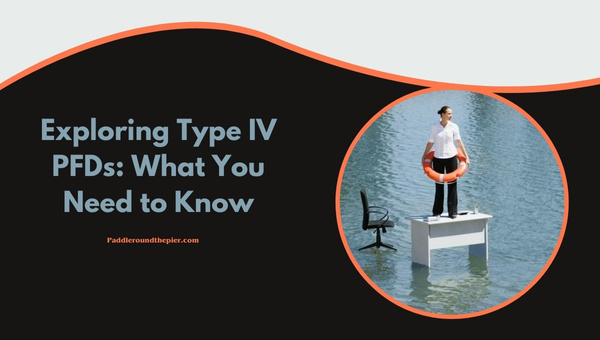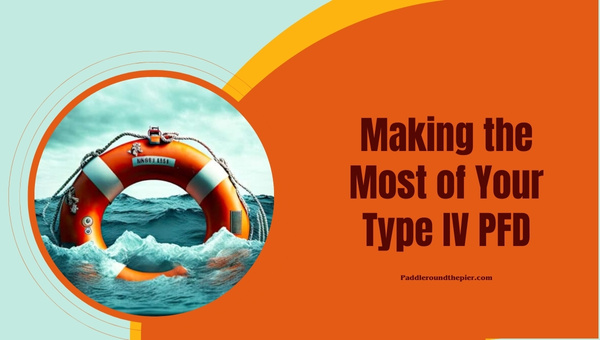Type IV PFD Advantage: Essential Benefits You Should Know 2025
Welcome aboard! As we set sail on our water adventure, safety is always a top priority. We all know the importance of personal flotation devices (PFDs), but do you understand the unique Type IV PFD advantage?
This article is your lifesaver, diving deep into the world of these throwable life preservers and revealing their undervalued benefits.
In a sea of floatation devices, a Type IV PFD definitely stands out, thanks to its distinct design and multiple safety advantages.
Not only is it easy to use—even for those who aren’t exactly Olympic swimmers—but it’s incredibly versatile and suitable for various watersport activities. But that's not all; keep reading to unlock more benefits!
Here's What You'll Discover:
- The unique features and design of a Type IV personal flotation device.
- How the ease of use significantly contributes to the Type IV PFD advantage.
- The surprising versatility this type of life preserver boasts.
- Ways to maintain longevity and effectiveness in your flotation cushion.
- Some critical factors to consider when choosing a Type IV life preserver for your aquatic adventures.
Exploring Type IV PFDs: What You Need to Know?
Regarding the open water, safety should be your main priority. One of the best ways to ensure this is with a Type IV PFD. But what exactly is this device and what makes it so unique? Let's dive into this subject matter with two main focal points:

What is a Type IV PFD?
At its simplest, a Type IV Personal Flotation Device (PFD) or in common speak, a life preserver, is an integral part of boating safety equipment as outlined by the U.S. Coast Guard. Particularly, here are some distinctive factors that set it apart:
- Throwable Devices: Unlike other types of PFDs that you wear like vests, a Type IV PFD is designed to be thrown to someone who has fallen overboard.
- One Size Fits All: The beauty of these flotation devices lies in their universality. Regardless of size or age, anyone can benefit from the buoyant support provided by a Type 4C personal flotation device.
- Safety Compliance: Worthy of note is that possessing at least one throwable device (Type IV) onboard vessels 16 feet or longer is compulsory based on U.S. Coast Guard regulations.
The Design of Type IV PFD
The design aspects play a huge role in establishing the unique benefits synonymous with this type of flotation device:
- Shape and Form: Typically ring-shaped or cushion-like in form factor, these aren't worn but can easily be tossed towards an overboard swimmer.
- Material Make-up: Made from buoyant materials – often foam - these are fundamentally engineered for durability that guarantees endurance even when subjected to harsh marine conditions.
- Visual Attraction: Predominantly bright-colored (often orange), acts as an attractor making them easy to spot during rescue missions.
With a clearer understanding of what a Type IV PFD is and its design features, you can begin to appreciate the vast advantages that these vital safety equipment present. Let's plunge into the next.
Also Read: Muscles Worked during Paddle Boarding: The Benefits
Delving into the Type IV PFD Advantage
As important as it is to recognize what a Type IV PFD is, it's just as vital to dive into the specific benefits or advantages they offer.
So why should you opt for this type of device over other lifesaving gear? As an owner and frequent user of these devices, I can assure you that there are plenty of reasons. Let's dig a little deeper.
Ease of Use
One clear-cut Type IV PFD advantage lies in its simple design and user-friendliness. This makes these devices not just accessible, but genuinely useful in crucial moments. Here's why:
- No complicated gearing up: Forget about intricate straps or perplexing adjustments - with Type IV PFD-like throwable life jackets or flotation cushions, all you need to do is toss them toward the individual needing assistance.
- Efficiency for all: They are easy to use even for non-swimmers or individuals with limited swimming abilities.
- Proactive Safety Measure: If you spot someone struggling in the water, you can quickly throw them your Type IV PFD without any hesitation or fumbling around.
Versatility
The versatility of the Type 4 personal flotation device graces it with an appealing charm that appeals to many boaters.
- Perfect Fit for Various Water Activities: These nifty devices are suitable for an assortment of water-related activities such as kayaking, fishing, cruising, paddleboarding - you name it!
- Not Strictly Person-Specific: Unlike some Types I, II & III life jackets which need to be personally fitted, these can be incredibly versatile due to their one-size-fits-all approach.
Improved Safety
When we focus on safety advantages concerning a Type IV PFD, here’s where they genuinely shine:
- Buoyancy: The material used allows people to stay afloat without extra effort.
- Visibility: Many PFDs are made with bright, vivid colors to be easily spotted in the water.
- Reliability: These devices are reliable, providing assurance that you have a tried and tested lifesaving tool on your boat.
In essence, considering the Type IV PFD advantage as your next safety investment for any water-related fun adds an extra level of convenience, flexibility, and enhanced safety. And these are benefits any boater would appreciate.
Also Read: Red River Gorge Kayaking: Explore the Breathtaking Beauty
Making the Most of Your Type IV PFD
As an adventurist, I've learned that maximizing the utility of my gear is essential. The same principle applies to my water safety equipment - particularly my Type IV PFD. My experience has taught me a thing or two about taking care of these devices and choosing the right one for specific needs.

Maintenance Tips
Maintaining your Type IV PFD can significantly prolong its lifespan and ensure it remains effective in emergency situations. Here are some tips I've gathered over time:
- Regular Inspection: Examine your PFD for signs of wear and tear, such as tears, abrasions, or loose straps regularly. Confronted by any of these signs? It's time for a replacement.
- Proper Cleaning: Clean your Type IV personal flotation device after each use to remove saltwater residue or dirt that could degrade its material over time.
- Storage: Always store your flotation cushion in a dry, ventilated place away from direct sunlight. Exposure to extreme temperatures may damage it.
- Avoiding Rough Handling: Avoid using your PFD as a kneeling pad or boat fender - it's not designed for these purposes and this could compromise its buoyancy.
Choosing the Right Type IV PFD
When it comes to embracing the full benefits of a Type IV life preserver, choosing an appropriate one is key. Here are certain factors you should consider before buying:
- Material Quality: Always opt for high-quality materials that resist UV light and water damage while offering long-term durability.
- Visibility: The throwable life jacket should be brightly colored or have reflective patches to improve visibility in water scenarios.
- Size & Fit: Check fitting guidelines provided by manufacturers – suitable PFDs shouldn’t be too tight or baggy.
- Flotation Performance: Does it provide enough buoyancy? Remember we're talking about a lifesaving device here - it should keep you afloat in the water.
- Comfort: If it’s not comfortable, you're less likely to use it. Fight that temptation by trying on your PFD for boating safety before purchasing.
FAQs
Are there different sizes available for Type IV PFDs?
Yes, indeed. Type IV PFDs come in all shapes and sizes. However, they are generally designed to be a one-size-fits-all solution that can accommodate nearly anyone, regardless of their size.
Can I use a Type IV PFD as my only life-saving device on my boat?
A Type IV PFD is an excellent add-on to your water safety gear. It's designed to enhance your safety net on the water but it's not intended to replace life jackets or other personal flotation devices (PFDs). Therefore, it shouldn't be your only line of defense.
What other safety measures should I take while using a Type IV PFD?
Apart from using the Type IV PFD correctly, ensure everyone onboard knows how to swim and use basic lifesaving skills. Always wear an appropriate life jacket and have an emergency plan in case of an unpredictable situation. Regular maintenance checks on all your boating safety equipment are also essential.
Conclusion
Having a Type IV PFD on board every time you hit the waters is not just a recommendation - it's the law and for several good reasons. It's an essential piece of safety equipment that can potentially save lives in emergencies.
Tooled with distinct benefits; ease of use, versatility, and enhanced safety features make it an excellent choice for most water-bound adventures.
Key Takeaway Points
- The major Type IV PFD advantage relies on its usability where even non-swimmers can operate with ease.
- Its versatility makes it suitable for different water activities, offering added value to users.
- Uncompromised safety is yet another significant benefit with features like boosted buoyancy and visibility ensured.
- Perfect maintenance can lead to increased longevity of these life-saving devices.
- Choosing the right Type IV PFD requires considering certain factors to get the best out of its attributes.